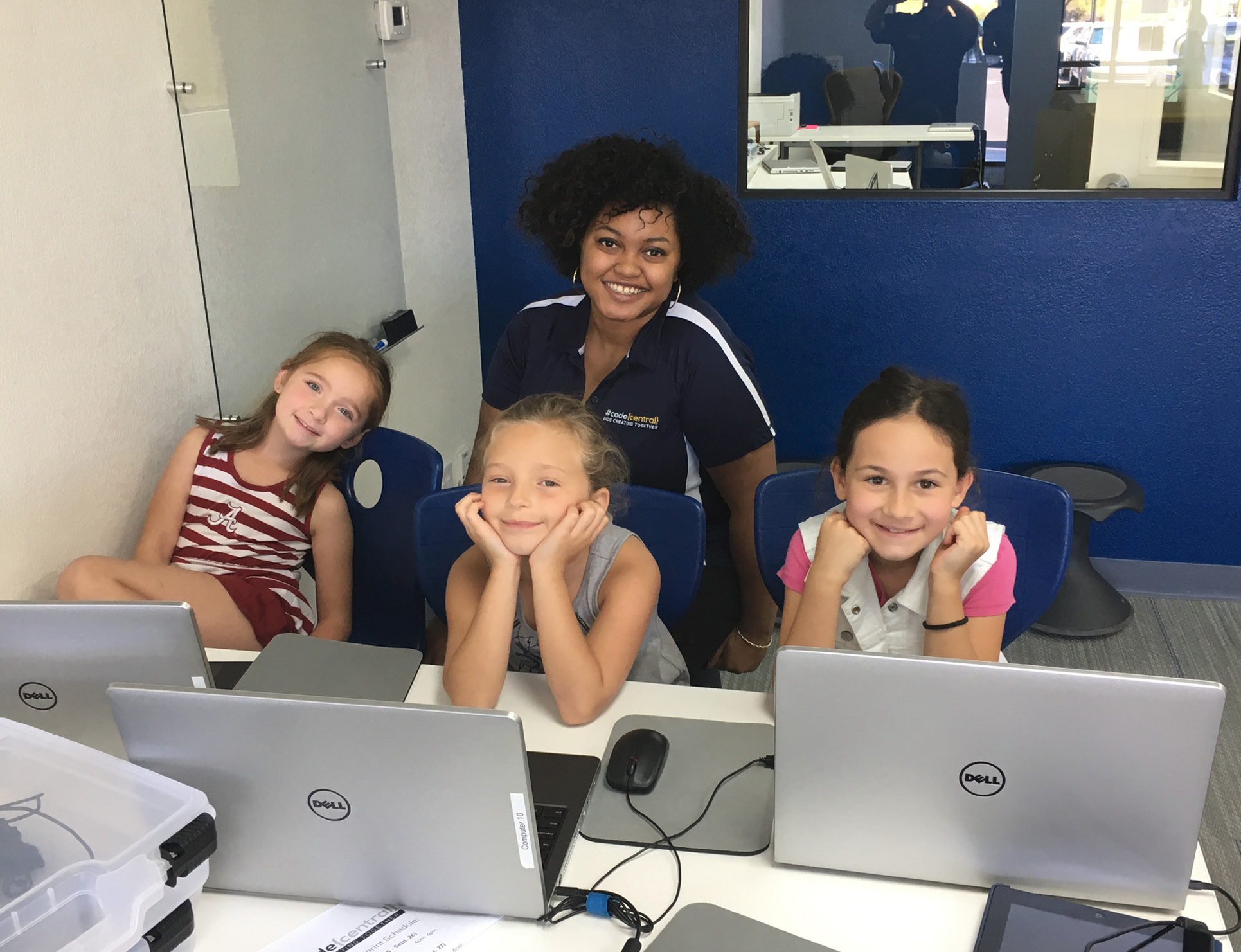STEM Girls

Instructor & students at Code Central
We have all heard the myth that boys are better at math and science than girls. And though this has been proven untrue time and time again, it has undeniably left some permanent scars on the computer industry. There are still significantly fewer women working in STEM (science, technology, engineering, and math) in the U.S. than men.
While women hold 57 percent of professional occupations, only 26 percent are professional computing occupations according to the National Center for Women in Information Technology.
As a UNLV student studying computer programming, Blair Bauman has seen the disparity firsthand.
“I always noticed when I walked into a classroom it is primarily men,” says Bauman, who graduates in December. “It was really difficult to make friends because I was one of only three females in my class.”
Not only do some of the male students in Bauman’s computer classes often avoid making eye contact with her, but others are a bit less subtle about their disdain.
“I asked for help once and one of my male classmates said, ‘What are you doing here? You should just drop out,’” she recalls. “It’s really discouraging to know that systemically this is…the attitude.”
Bauman often feels like she must work harder to prove herself than the men, but she does not let their negative attitude discourage her. She has managed to make friends with both men and women in the department, and even co-founded a local initiative called Girls in Tech, aiming to expose young girls to computer fields and change the gender norm.
“It’s good to get them at a young age, before those myths are ingrained,” she explains, “to organically nurture their interests before [someone tells them] ‘You really shouldn’t be doing this, anyway.’”
Eric Mendelsohn, co-founder of the after-school technology center Code Central, agrees that exposure is the key to attracting females to the tech industry.
“Girls aren’t encouraged as much as boys to get into tech,” explains Mendelsohn, noting that “you absorb it so much more effectively when you’re young.”
At his centers, youth ages 7 to 17 learn coding through web design, game and app development, and robotics. While enrollment usually skews about 65 percent male, 35 percent female, he is attempting to bridge the gender gap by offering an all-girls coding camp this summer.
Bauman works as an instructor at Code Central and will lead the all-girls camp. She is excited to work with a female group because she says the girls are often afraid to ask questions in mixed company; and they worry about being shamed if they get the wrong answer.
She also touts the importance of classes with both male and female students, noting that the interaction is positive for the male students, who sometimes come to Code Central with prejudices they learn from their parents.
“I’ve had little boys tell me that they don’t want my help because I don’t know how to program,” she recalls. “One boy, very young, like 7, told me, ‘Why don’t you go paint your nails?’ By exposing them young to the reality that there’s going to be diverse people around you, that’s a positive.”
Mendelsohn notes that some of his female students are Girl Scouts, working to earn badges including digital art, science and technology, and innovation. The Girl Scouts organization refreshed its program in 2017 to better reflect the interest of 21st century girls and hopes to bridge the STEM gender gap by bringing 2.5 million girls into the STEM pipeline by 2025.
Katie Spratt, 11, has been attending Code Central for the past couple years and is currently working on developing an app for her little sisters.
“I like figuring out logical programs with it and basically learning something new that a lot of people don’t know,” she says. “It’s not something you learn in school every day or have the opportunity to do everywhere.”
She admits most of her female friends aren’t into computer programming, but she thinks they would love it if they gave it a try.
“Most girls aren’t interested in technology,” she says, adding, “I think it’s really fun…and there’s a lot of materials you can use in coding that make your creative juices flow.”
Spratt points out that there have been a lot of major contributions to STEM by women. In fact, while researching female computer programmers for a project at school, the fifth grader discovered one of the world’s earliest computer programmers was a woman, English mathematician and writer Ada Lovelace, who, in the mid-1800s, published the first algorithm for a computer.
“I don’t think it matters if you’re a boy or a girl when you’re doing science because you’re around people who want to do the same thing,” she says.
Some other women of note in STEM include Hollywood actresses Danica McKellar (math), Mayim Bialik (neuroscience) and Natalie Portman (science).
Nevada’s own Jackie Rosen (D-NV) was a computer programmer and software developer before being elected to the U.S. Senate. She has made it a top priority to encourage young girls to pursue computer science and prioritize the learning and teaching of STEM subjects in early childhood.
In late March, Rosen introduced the bipartisan Building Blocks of STEM Act alongside other senators including Catherine Cortez Masto (D-NV). The bill aims to expand STEM education initiatives for young children and create new research grants to increase the participation of girls in computer science.
“It is so important for young children, especially our girls, to be introduced to opportunities available to them in the fields of science, technology, engineering, and math,” said Rosen. “As a computer programmer, I faced adversity in what has long been considered a male-dominated field and I’m working to break down those barriers for our current and future generations.”
